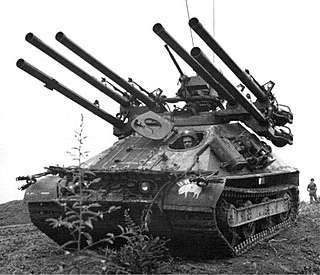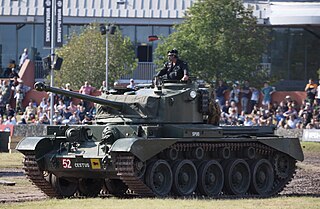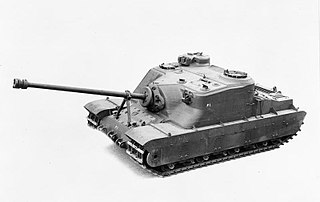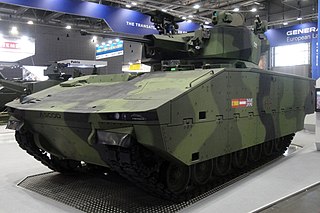
A recoilless rifle, recoilless launcher or recoilless gun, sometimes abbreviated "RR" or "RCL" is a type of lightweight artillery system or man-portable launcher that is designed to eject some form of countermass such as propellant gas from the rear of the weapon at the moment of firing, creating forward thrust that counteracts most of the weapon's recoil. This allows for the elimination of much of the heavy and bulky recoil-counteracting equipment of a conventional cannon as well as a thinner-walled barrel, and thus the launch of a relatively large projectile from a platform that would not be capable of handling the weight or recoil of a conventional gun of the same size. Technically, only devices that use spin-stabilized projectiles fired from a rifled barrel are recoilless rifles, while smoothbore variants are recoilless guns. This distinction is often lost, and both are often called recoilless rifles.

Ontos, officially the Rifle, Multiple 106 mm, Self-propelled, M50, was a U.S. light armored tracked anti-tank vehicle developed in the 1950s.

The Stridsvagn 103, also known as the Alternative S and S-tank, is a Swedish post-World War II main battle tank, designed and manufactured in Sweden. "Strv" is the Swedish military abbreviation of stridsvagn, Swedish for chariot and tank, while the 103 comes from being the third tank in Swedish service to be equipped with a 10 cm gun.

The Comet tank or Tank, Cruiser, Comet I (A34) was a British cruiser tank that first saw use near the end of the Second World War, during the Western Allied invasion of Germany. The Comet was developed from the earlier Cromwell tank and mounted the new 17 pdr High Velocity (HV) gun, in a lower profile, partly-cast turret. This gun was effective against late-war German tanks, including the Panther at medium range, and the Tiger.

The PT-91 Twardy is a Polish main battle tank. A development of the T-72M1, it entered service in 1995. The PT-91 was designed at the OBRUM and is produced by the Bumar Łabędy company, part of the Bumar Group, a Polish technical military consortium. Changes from the T-72M include a new dual-axis stabilized fire-control system, reactive armour, a more powerful engine, transmission and new automatic loader.

The FV4201 Chieftain was the main battle tank of the United Kingdom during the 1960s-1990s.

The Tortoise heavy assault tank (A39) was a British heavy assault gun design developed during the Second World War, but never put into mass production. It was developed for the task of clearing heavily fortified areas such as the Siegfried Line and as a result favoured armour protection over mobility.

The FV432 is the armoured personnel carrier variant in the British Army's FV430 series of armoured fighting vehicles. Since its introduction in the 1960s, it has been the most common variant, being used for transporting infantry on the battlefield. At its peak in the 1980s, almost 2,500 vehicles were in use.

The FV 214 Conqueror, also known as "Tank, Heavy No. 1, 120 mm Gun, Conqueror" was a British heavy tank of the post-World War II era. It was developed as a response to the Soviet IS-3 heavy tank. The Conqueror's main armament, an L1 120 mm gun, was larger than the 20-pounder (83.4 mm) gun carried by its peer, the Centurion. The Conqueror's role was to provide long range anti-tank support for the Centurion. Conquerors were issued at nine for each regiment in Germany, usually grouped in three tank troops. In the British Army both the Conqueror and the Centurion were replaced by the Chieftain.

The ASCOD armoured fighting vehicle family is the product of a cooperation agreement between Austrian Steyr-Daimler-Puch AG and Spanish General Dynamics Santa Bárbara Sistemas. The ASCOD family includes the LT 105, a light tank equipped with a 105 mm gun, a surface-to-air missile (SAM) launcher, an anti-tank missile launcher, mortar carrier, R&R vehicle, Command & Control vehicle, ambulance, artillery observer, and the AIFV model. In Spanish service, the vehicle is called "Pizarro", while the Austrian version is called "Ulan".

The FV721 Fox Combat Vehicle Reconnaissance (Wheeled) was a 4 × 4 armoured car manufactured by ROF Leeds, deployed by the British Army as a replacement for the Ferret scout car and the Saladin armoured car. The Fox was introduced into service with B Squadron, 1st Royal Tank Regiment in 1975 and withdrawn from service 1993–94.

A spotting rifle or ranging gun is a small-calibre rifle used as a sighting device for artillery. The ballistics of the spotting rifle are matched to those of the artillery piece, so that if a shot from the spotting rifle lands on the target, it may be assumed that the main weapon will also do so.

The 2S25 Sprut-SD is a self-propelled anti-tank gun developed and manufactured by the Volgograd Tractor Plant to meet the requirements of the VDV. In mid-2001, the Volgograd tractor plant revealed that the development of the 2S25 had lasted several years.

The BMP series were among the first production line infantry fighting vehicles. Included in the series are the mainline BMPs, the airborne variant BMDs, and licensed modified and reverse engineered versions. BMP stands for Boyevaya Mashina Pekhoty, meaning "infantry fighting vehicle". They were initially developed in the 1960s in the Soviet Union.

The Versuchsträger1-2 were two German prototype twin gun turretless main battle tanks. Since the early 1970s a number of West German companies have been working on conceptual designs for a successor to the Leopard 1. This project had the name Kampfpanzer 3. The KPz 3 project was temporarily a British-German joint project, until the UK withdrew because they wanted a turreted tank. The Germans had already developed the Leopard 2 and therefore didn't see the need for another conventional tank. One of the companies involved was MaK, developing the VT 1-1 and VT 1-2. The test programme ended proving that a twin-gunned turretless tank could be created with enough technical effort, but had drawbacks in both practical and tactical use.

An oscillating turret is a form of turret for armoured fighting vehicles, both tanks and armoured cars. The turret is unusual in being made of two hinged parts. Elevation of the gun relies on the upper part of the turret moving relative to the lower part.

The ELC project was a prototype light tank project launched by the French Ministry of Defense in 1955. The purpose of the ELC project was to develop a lightly armoured, heavily armed fighting vehicle capable of being airlifted for rapid deployment.
The Vickers Main Battle Tank Mk. 4 later known as the Vickers Valiant was a main battle tank developed as a private venture by British company Vickers for export. Its development began in 1976 and ended in January 1984. Although the Valiant did not enter production, its development provided valuable experience in the production of an aluminium-hulled, Chobham-armoured tank in the 40 tonnes weight range. A further development of its turret was later used for the Vickers Mk. 7 MBT.

















